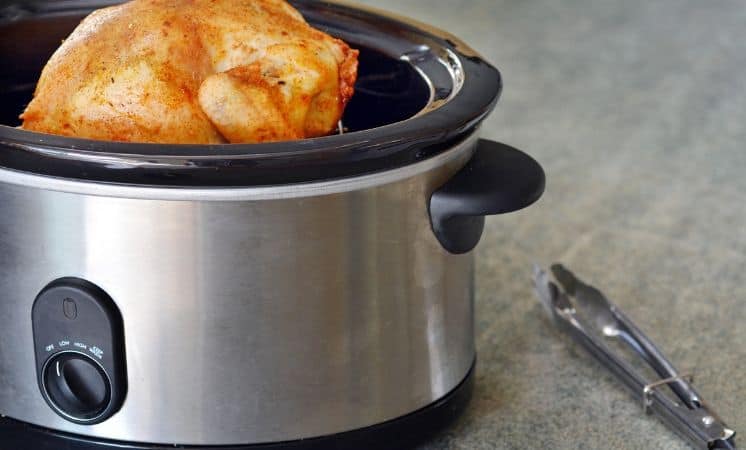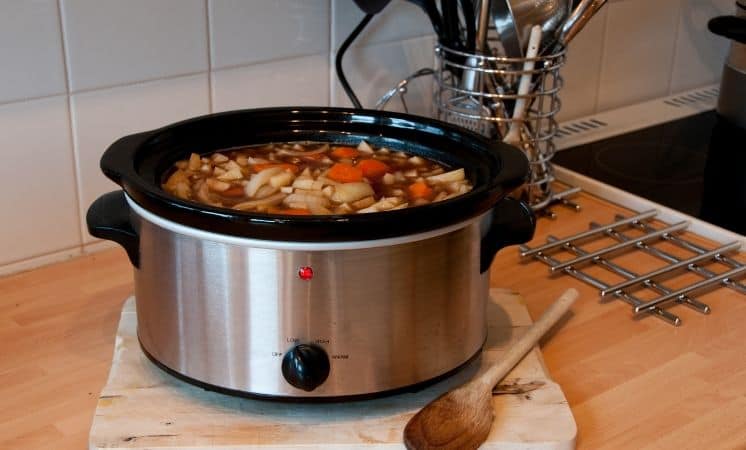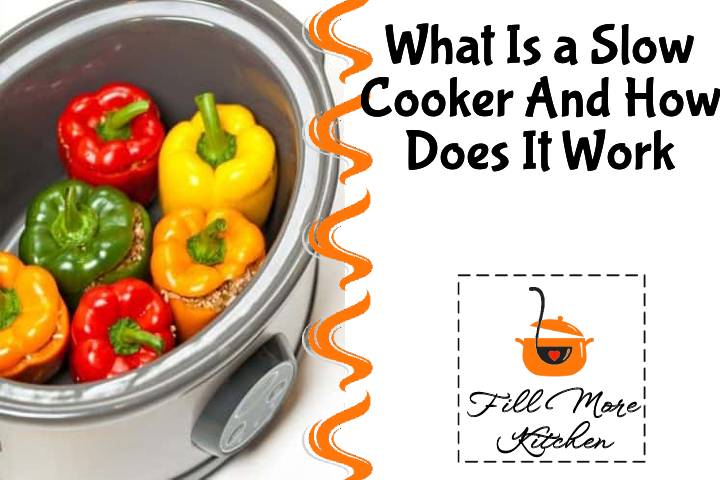Slow cookers, as their name implies, are a type of cooking appliance that prepares food by cooking it at low temperatures over an extended period. The slow cooker comprises three main components;
- The lid.
- Both the inner and outer casing of the slow cooker pot.
- The heating element.
When combined, these components enable the slow cooker to function for extended periods of time, ultimately producing a delectable dish.
As I always evaluate the cost of a product by listing its advantages and disadvantages in separate columns to determine which one is more significant, I conducted some research on the appliance before buying it.
After years of owning and utilizing my slow cooker, I aim to impart the knowledge I gathered before buying it and the insights I gained from using it.
Our initial inquiry is answered (although there is more to learn about slow cookers before making a purchase).
Slow cookers are electric devices that are utilized to prepare meals at low temperatures over an extended period, making even the toughest meat cuts tender and juicy. During cooking, the slow cooker’s lid and container are sealed, which traps moisture inside the device and keeps the food moist.
Slow cookers can be left unattended due to their low operating temperatures, but it is crucial to comprehend their functioning and purpose. Even the safest appliance must be used as per instructions.
How Does a Slow Cooker Work?
The three parts of the slow cooker work together to make it function properly.
The metal shell of the slow cooker contains the heating coils that are responsible for heating up the inner pot during the cooking process. While the inner pot is typically made of ceramic, there are also options available in stainless steel and aluminum. This is where all the ingredients are placed and cooked.
The lid is placed on top of the main unit to close and seal the slow cooker.
Having knowledge of the components that make up the slow cooker, we can further explore how it utilizes these parts to prepare our food.
Upon activation, the slow cooker‘s heating coils initiate the warming of both the outer shell and the area between the casing and pot. The indirect heat generated by these elements will gradually raise the temperature of the inner pot to a range of 180-300 degrees Fahrenheit or 82-149 degrees Celsius, depending on factors such as wattage, size, and selected setting.
Due to the low temperature of the slow cooker, anything put inside it will simmer for an extended period, causing the food to release steam that creates a vacuum seal, similar to a pressure cooker, which keeps the lid locked onto the pot.
Moreover, the moisture generated by the steam within the slow cooker maintains the tenderness and juiciness of its contents, provided that the cooking time and ingredients are appropriate for the dish being prepared.
After completing a cooking cycle, the slow cooker typically switches to “keep warm” mode, which guarantees that you will have a hot meal waiting for you when you return home. This is one of the many advantages of using a slow cooker; it can be left unattended for several hours while you engage in other enjoyable activities and still yield excellent outcomes.
Using a slow cooker doesn’t necessarily mean spending a lot of time in the kitchen, despite the fact that it takes several hours. Prior to leaving for work, I ensure that all the ingredients are added to the slow cooker, and then I set it to cook on the preferred setting (low, high or off). Later, after a few hours have passed, I return home to find a delectable meal waiting for me.
For optimal outcomes, the majority of the recipes I use recommend cooking on low for 6-8 hours, although occasionally it may require nearly 10 hours to slow cook a dish.
What Are the Advantages Of Using a Slow Cooker?
- Time-saving: The slow cooker’s automation allows you to leave it alone and effortlessly cook a tasty meal.
- Energy Efficient: You may assume that running an appliance for hours would be costly, but the slow cooker is actually quite inexpensive to use. Everydaygoodthinking states that a small slow cooker uses as much energy as one and a half 100 watt light bulbs.Everydaygoodthinking.
- Cost-effective: To begin with, utilizing a slow cooker is an effortless method to guarantee that you always have food available at home, which prevents you from purchasing takeout. Furthermore, the slow cooker has the ability to prepare a delectable dish using even the most economical meat cuts due to their tender and succulent outcome.
- Simple Maintenance: The slow cooker can be easily cleaned in just a minute, and it eliminates the need for multiple pots as all ingredients can be cooked in one pot.
- Portable: Slow cookers can be easily transported to different locations depending on their size, which is convenient for frequent travelers or those who reside in multiple places.
How Much Does a Slow Cooker Cost?

Although kitchen appliances can be expensive, the slow cooker is not a new product and has been reintroduced to the market, providing excellent results at an affordable price.
With the release of new products and massive advertising budgets, hype is created around them; however, the slow cooker has already passed through this phase and settled. Although I usually adhere to the principle of “you get what you pay for,” I think that with a slow cooker, you receive more value than what you paid for.
The actual price of a slow cooker depends on various factors such as model, brand, size, and features. While some basic models can be purchased for as low as $20, the high-end ones with multiple features can cost up to $100.
Slow cookers of various price ranges, including both $20 and $100 models, are available on Amazon’s list of top-selling products.
What Are Slow Cookers Used For?
Slow cookers are commonly utilized for cooking food that would typically be boiled, but they have a broad range of applications. Some of the most frequently cooked items in a slow cooker include:
- Meat
- Vegetables
- Soups
- Stews
- Dips
- Grains
- Bread
- Desserts
- Cakes
- ….and more.
While slow cookers are versatile in terms of ingredients, there are certain items that should be avoided during the cooking process.
- Dairy: It is highly probable that it will coagulate in the slow cooker.
- Pasta, Rice, and Couscous: It is recommended to cook them in a different pot.
- Lean meat: When cooking with a slow cooker, tougher cuts of meat become more tender, but lean meats like chicken breast can become tough and chewy unless cooked properly; the same is true for most seafood, although octopus and squid are exceptions.
- Tender vegetables: Although the slow cooker is suitable for cooking vegetables, it’s advisable to limit its use to sturdy root vegetables as more delicate ones such as peas and asparagus will become a soft, unappetizing puree.
- Uncooked meat: It is recommended to sear the meat in a pan before placing it in the slow cooker as it improves the taste.
- Seasonings: It is advisable to add spicy ingredients like chili after the slow cooking process as they tend to become spicier with prolonged cooking. Unless you prefer extremely spicy food, it is better to add these seasonings at the end of the slow cooking.
Are Slow Cookers Safe?
In general, slow cookers can be used safely for extended periods at low temperatures, but it is still crucial to remember a few things to minimize the chances of an accident while using one.
- Avoid reheating food in the slow cooker: It is not recommended to reheat any meal, whether cooked in a slow cooker or not, in the slow cooker as it may take too long for the meal to reach safe temperatures. Instead, refrigerate the meal within 1-2 hours after cooking and use a microwave for reheating.
- Position the slow cooker on a secure surface: It is recommended to place your slow cooker on a kitchen counter or any other surface that can withstand heat. Ensure that there are no flammable materials or water nearby or beneath the appliance.
- During the initial uses, it is advisable to stay near the slow cooker despite its ability to be left unattended, as this will help ensure that it functions properly.
- Defrost ingredients before cooking: It is highly recommended by most manufacturers to defrost or thaw the ingredients before placing them in the slow cooker. This step is crucial to ensure that all the components are cooked evenly and thoroughly after the cooking cycle is complete. The slow cooker may not be able to handle large frozen pieces of food, which could result in undercooked food.
- Choose a slow cooker that has a keep warm feature: Modern slow cookers are equipped with a keep warm mode, as previously mentioned. Rather than shutting off after cooking, the slow cooker switches to keep warm mode to maintain safe temperatures and prevent bacterial growth in your food.
Is a Slow Cooker a Crock-Pot?

It’s likely that you’re familiar with both slow cookers and crock-pots, but do they differ from one another? Essentially, there is no distinction between crock-pots and slow cookers.
Essentially, a Crock-Pot is a type of slow cooker that has become popular and influenced the development of other slow cookers. So while all Crock-Pots are slow cookers, not all slow cookers are Crock-Pots.
The first slow cooker, known as the Crock-Pot, was launched in 1970 and has undergone enhancements that have transformed it into the efficient and user-friendly cooking device we rely on today.
Having said that, Crock-Pots and slow cookers have a similar appearance, yield comparable outcomes, and include a cover, an enclosure, and a heating component.
It is evident that slow cookers have a resemblance to each other, but the cookware’s composition and included characteristics may differ based on the brand you choose.
What Should You Look For When Buying a Slow Cooker?
If you are considering purchasing your initial or an improved slow cooker, there are certain aspects to consider that will depend on your specific requirements and goals.
- Material of the lid: The lid of a slow cooker has a crucial function in retaining the heat inside the pot, which is necessary for slow cooking. If you open the lid of the slow cooker, it will decrease the temperature within the pot. Hence, it is advisable to choose a slow cooker that has a glass lid so that you can inspect the food without uncovering it.
- Size: Slow cookers come in various sizes, and the ideal one for you depends on your intended use. If you intend to prepare sauces, dips, or small meals for one person, a small slow cooker will suffice. However, if you plan to cook for a family or in large quantities, it is advisable to purchase a larger slow cooker with a capacity of 6 quarts or more.
- Function for keeping food warm: The slow cooker has a function that keeps your food warm after it has finished cooking, which is useful if you intend to cook slowly while you are away from home and want to return to a hot meal.
- Crock material: Slow cookers typically feature crocks made of either ceramic or porcelain, although metal options are also available, and the choice ultimately depends on individual taste.
My all-time favorite is the Hamilton Beach 33195, it has everything I need and is large enough to cook for my family. The fact that the cooker is listed at a very good price on Amazon doesn’t hurt one bit.
Can You Leave a Slow Cooker On Overnight?
As someone who used a slow cooker often during the day while working, I eventually began utilizing it overnight while sleeping, resulting in a fully cooked meal upon waking that could be taken to work and saved for future consumption.
One may have concerns about the safety of using an appliance with a heating element.
It is advisable to adhere to the manufacturer’s guidelines for safety when using a slow cooker. It is recommended to remain close to the appliance during the initial uses, and it is not recommended to use it without thoroughly reading the provided instructions.
Using a slow cooker is a common practice among many individuals worldwide, including myself and my family. However, it is important to note that leaving the appliance unattended can be risky, so it is crucial to conduct thorough research beforehand. Fortunately, there are numerous resources available both online and offline to assist with this.
I have already discussed the basic safety rules for slow cookers above, but I still suggest that you read more. This Huffpost article provides further information.
Conclusion: Do You Need a Slow Cooker?
Using the term “need” may seem overly dramatic, but a slow cooker has certainly improved my daily routine by making it more convenient and less stressful. It has given me the extra time I require to engage in activities that bring me joy and energy, while still allowing me to fulfill my responsibilities of work, family, and self-care.
Among my kitchen appliances, the slow cooker remains one of my top picks due to its ability to make cooking ten times easier and its user-friendly nature. It has been instrumental in helping me maintain a healthy diet by ensuring that I always have home-cooked meals available, preventing me from buying unhealthy food.
If you’re searching for a budget-friendly appliance that can create delicious meals with minimal effort, then the slow cooker is an excellent choice. If you’re having trouble picturing how to use the cooker, head over to Pinterest and browse through the vast collection of mouth-watering slow cooker recipes.
You can also check this video about “What Is a Slow Cooker And How Does It Work?”
Check out our top 10 reviews!
Related posts
https://fillmorekitchen.com/does-sriracha-need-to-be-refrigerated/
https://fillmorekitchen.com/how-long-does-royal-icing-last/
https://fillmorekitchen.com/what-to-do-if-your-dishwasher-says-check-water/
https://fillmorekitchen.com/can-you-run-an-empty-dishwasher-to-clean-it/
https://fillmorekitchen.com/how-long-can-taco-bell-meals-be-left-unrefrigerated/



